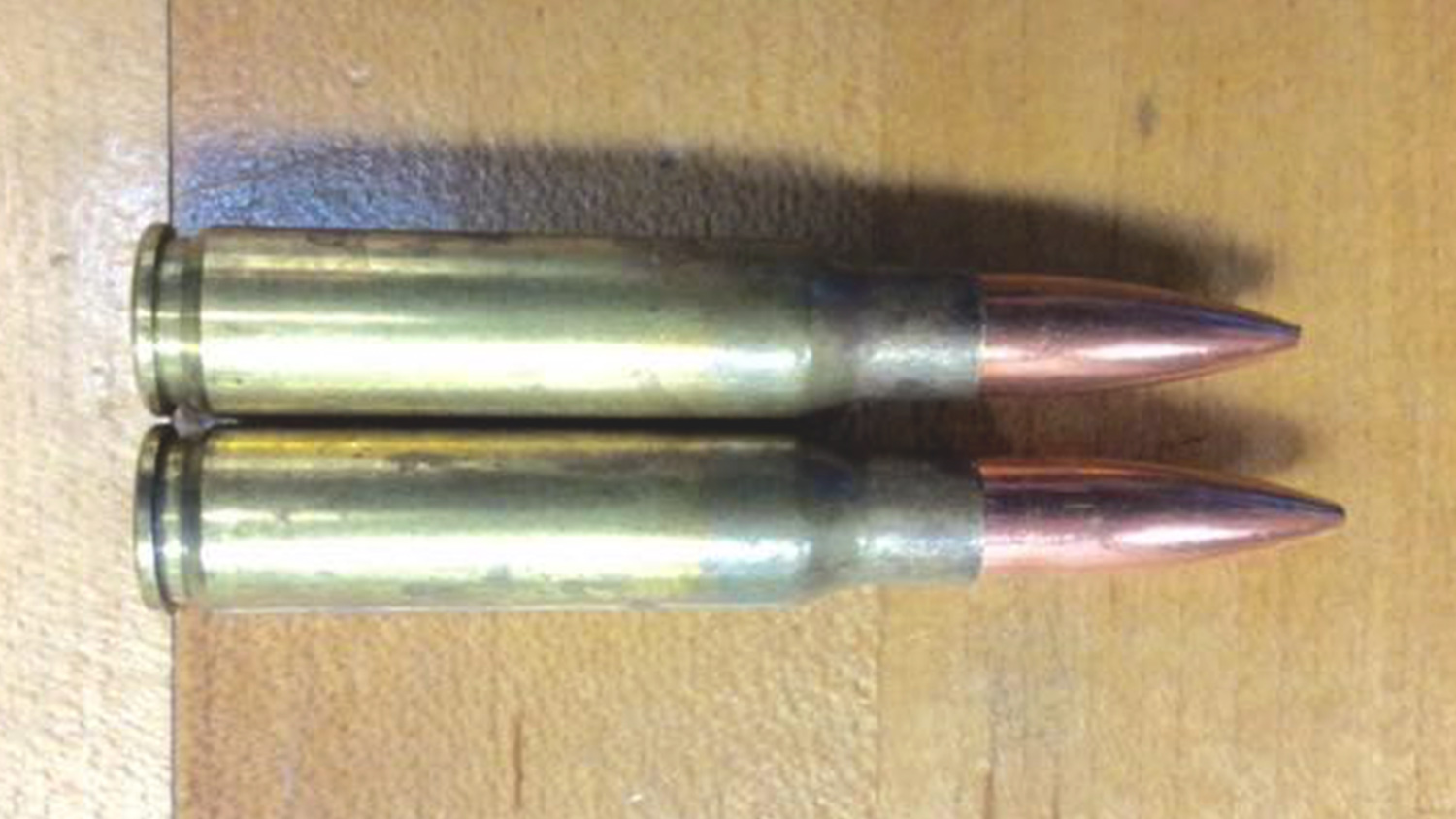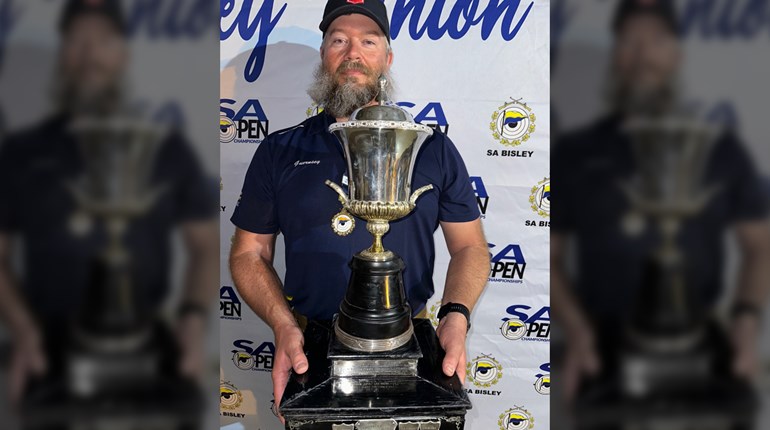
WARNING: All technical data in this publication, especially for handloading, reflect the limited experience of individuals using specific tools, products, equipment and components under specific conditions and circumstances not necessarily reported in the article and over which the National Rifle Association (NRA) has no control. The data has not otherwise been tested or verified by the NRA. The NRA, its agents, officers and employees accept no responsibility for the results obtained by persons using such data and disclaim all liability for any consequential injuries or damages.
Above: A poorly-planned reamer or improper throating can cause a variety of problems. Pictured are identical bullets; the one on top is seated to correct magazine length. Note relationship of bullet ogives.
In this article we discuss some basic issues to help newer competitive shooters avoid pitfalls while optimizing their ammunition and chambers.
Before we can delve into specific chamber issues, however, we must lay some groundwork. Within NRA High Power Rifle and Long-Range competition, two broad divisions exist: Service Rifle (semi-auto) and Match Rifle (which could be either a bolt action or semi-auto.) The different rifle mechanisms have somewhat different ammunition requirements; in this series, we will address both types.
The custom riflesmith you choose to fit and chamber your barrel should, ideally, be a tremendous resource for information and helpful, real-world advice. Many pitfalls can be avoided by consulting a wise one. However, as in all other aspects of life, not all gunsmiths are created equal. Taking care to choose an experienced, talented, meticulous riflesmith for your custom project is vital to your ultimate success. Research his qualifications, background and achievements; be sure to consult several *known and knowledgeable* customers about their personal experiences with his work.
*Beware* the “darlings” of the internet, who gain legions of blind followers on various forums who parrot their praises—while having had no actual experience with the ‘smith, or his work, whatsoever. This situation is often accompanied by a “groupthink” mentality. I.e., anyone who dares to openly question or report known poor performance of the designated “Forum Darling” may be pounced upon by a mob and charged with heresy. If “unknowns” on the internet are vocal in singing the praises of a particular ‘smith, politely inquire—privately, if necessary—what their personal experience with the ‘smith has been.
Surprisingly often, they will admit they, themselves, have never worked with the ‘smith or even seen his work, but that “everybody says” he’s superb. This phenomenon is far more common than some might think, and some absolutely terrible ‘smiths regularly profit by it. This author is personally familiar with several cases in which valuable guns were ruined, and several hundreds of dollars were lost, per incident, for this very reason. Due diligence applied beforehand can save months or even years of wasted time, frustration, and lost money/competition opportunities in the future! A very basic performance bar to ascertain early on in your research is whether or not the ‘smith will truly honor a *valid* warranty claim.
While this seems a simple qualification, verifying that the ‘smith actually honors his commitments can save hundreds (thousands?) of dollars and years of unpleasant experiences in the course of a few builds. An example of how a ‘smith can avoid standing behind his work was inflicted upon the author early in his competitive shooting career. It has since become known as the “Here, Try This” Game. The author had a National Match M1 built by a recognized (but not famous) Service Rifle ‘smith, which resolutely refused to yield even marginal competitive accuracy. M1’s and M1A’s (civilian M14’s) being complicated beasties makes them prime candidates for the “non-warranty” warranty. Things are now much better with the AR15, but the principle is the same.
The M1 has been built with a new, match barrel, glass-bedded, gas system and handguards tuned, etc. When test targets were brought to the ‘smith and a remedy requested, he acquiesced. Six weeks later, he called to say the rifle was “ready”. Upon picking up the “repaired” rifle, the author was informed that the operating rod had been “tweaked” and it “should” help. The ‘smith hadn’t bothered to test it, leaving the author to do so at his own time/expense. Many expensive match bullets and 240 miles driven later, the rifle showed no improvement whatsoever.
Back to the ‘smith it went. After it had accumulated the appropriate amount of cobwebs, he was called to pick up the rifle. Bad omen: as he accepted the supposedly “repaired” rifle, he was again told to test fire it, with the increasingly frustrating comment, “Here, try this.” More expensive match ammo and another 120 mile range trip later, there was still no improvement. A third inning of “Here, try this” ended similarly. It became obvious that the ‘smith could play this game indefinitely, with absolutely no effort, expense, or inconvenience on his part.
Belatedly, the author realized that the smith had no intention of actually making good on the work for which he’d been paid. Off he went to another Service Rifle ‘smith, who re-glassed the M1 as the cheapest ($75) option with a hope of success. Nope. In desperation, a new match barrel was installed. Bingo! The rifle was now a tack-driver, but the author was out two years of competitive use, several hundred dollars, several boxes of expensive match ammo, and much patience.
Some ‘smiths focus on semi-auto “gas guns”, others on bolt action match rifles, and still others on specialized exotica such as pure benchrest competition rifles. Techniques that produce outstanding results in rifles for one discipline may not be remotely appropriate for another. Moreover, a ‘smith may build exceptional gas guns but be poor at building bolt actions, or vice versa. Many years ago, a popular author in the world of NRA Service Rifle competition coined a cautionary catchphrase that “Service Rifles Are Not Benchrest Rifles!” This accompanied his warnings to handloaders who were tempted to fit their cartridges to their chambers with ultra-tight tolerances in the never-ending quest for “just a smidgeon more accuracy!” That warning still bears repeating today.
Particularly regarding M1A/M14’s (which ruled Service Rifle at the time) and M1 Garands—that practice can contribute significantly to slam-fires. A slam-fire which occurs when the bolt is not locked in battery can result in rifle destruction, shrapnel and serious injury to the shooter. Different mechanisms have differing proclivities for this type slam-fire due to their design. Happily, the AR15 is not nearly as prone to this issue as the M1/M14/M1A. However, a very close cartridge/chamber fit is not recommended for use in Service Rifles/semi-auto match rifles, including the AR15, for reasons of both safety and reliability.
As shooters begin to purchase custom barrels engineered for highest accuracy, questions such as optimum rifling twist, throat length and form, and loaded case-neck clearance begin to arise. Here, hopefully your wise riflesmith can offer invaluable advice. Very likely, he may have one or more custom chamber reamers in your caliber of interest, and can explain their differences and the special advantages of each. Other times, the customer may wish to use a caliber for which the ‘smith does not have a reamer.
In such instances, an experienced, knowledgeable ‘smith can still guide the customer toward an excellent solution for his application. It’s not uncommon for the ‘smith to share the cost of a reamer in a popular caliber with the customer, and then keep it in his inventory. Other times, the customer may wish to purchase the reamer himself and keep it—particularly if he anticipates having multiple barrels chambered with it over the years.
When working with a riflesmith to obtain a specialized reamer for a project, there are some less obvious aspects that newer shooters should bear in mind. These include optimizing the reamer for the particular bullets the shooter intends to use, allowing enough flexibility to accommodate a variety of suitable bullets, and ensuring that the chamber throat is not excessively long. When the latter occurs, cartridge overall length (OAL) may be so long that when bullets are seated near the rifling for accuracy, the cartridges will no longer fit in the magazine.
Other times, an excessively long throat, while compatible with certain magazine-fed ammunition, will prevent using light (i.e., short) bullets for practice or low-recoil applications. Simply put, a throat like this prevents seating light bullets with adequate bearing surface in the case neck when the ogive is appropriately close to the rifling. Obviously, this situation limits the shooter’s options for his rifle’s applications, and this possibility should be carefully addressed.
SSUSA thanks the U.S. Army Marksmanship Unit for allowing the reprint of this article.


































